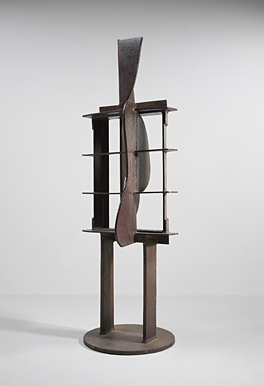
|
ABOVE: David Smith, Voltri XVII, 1962. Steel, 95 x 31 3/8 x 30 3/4 inches. Collection of Lois and Georges de Menil, New York. Photo by David Heald © 2006 The Estate of David Smith/Licensed by VAGA, New York.
|
|
|






In 1962, the Italian government invited Smith to make two sculptures for the fourth Festival of Two Worlds in Spoleto, Italy. Italsider, the national Italian steel company, gave him access to five abandoned welding factories near Genoa, and he chose one in the small town of Voltri for his studio. Although he had intended to work in stainless steel, Smith quickly changed his mind upon discovering the wealth of extant materials in the old factory, and in an extraordinary burst of creativity he welded 27 sculptures in just 30 days.
Smith assembled his Voltri sculptures largely from found tools and scraps of steel, and despite a range of construction styles he maintained a remarkable coherence in the series. Inspired by the ancient Roman surroundings, he did not paint or burnish his steel, as he had in Bolton Landing, but retained its rusty natural color, giving the Voltris an impression of considerable age. In many pieces Smith ostentatiously preserved the identity of found objects such as tongs, work tables, and industrial carts, while in others he welded together more abstract metal fragments that had been cast off during factory operations. Many of these elements were left behind when shapes were cut from steel sheets; due to their irregular curves and abrupt angles, the artist called them “chopped clouds.” During his frenzied month of production in Italy, Smith assembled these and similar components with a grace and elegance that made the Voltris some of his most compelling pieces to date.
When his sojourn in Voltri ended, Smith shipped several tons of unused, found factory objects to Bolton Landing, so that he could continue working with them. In winter 1962–63 he created a series of works titled alternately Voltron, Voltri-Bolton, or V.B. that expanded upon many of the formal themes of his Voltris. No longer compelled to work quickly, Smith introduced more intricate compositions into these sculptures, and, back in the familiar setting of his studio, he also imbued them with aspects of his pieces made prior to his time in Italy. Most notably, the Voltri-Boltons adopted the vertical orientation and round elements of his Tanktotem series, and joining those works and others in the fields around his house, they too came to be seen as personages.
|